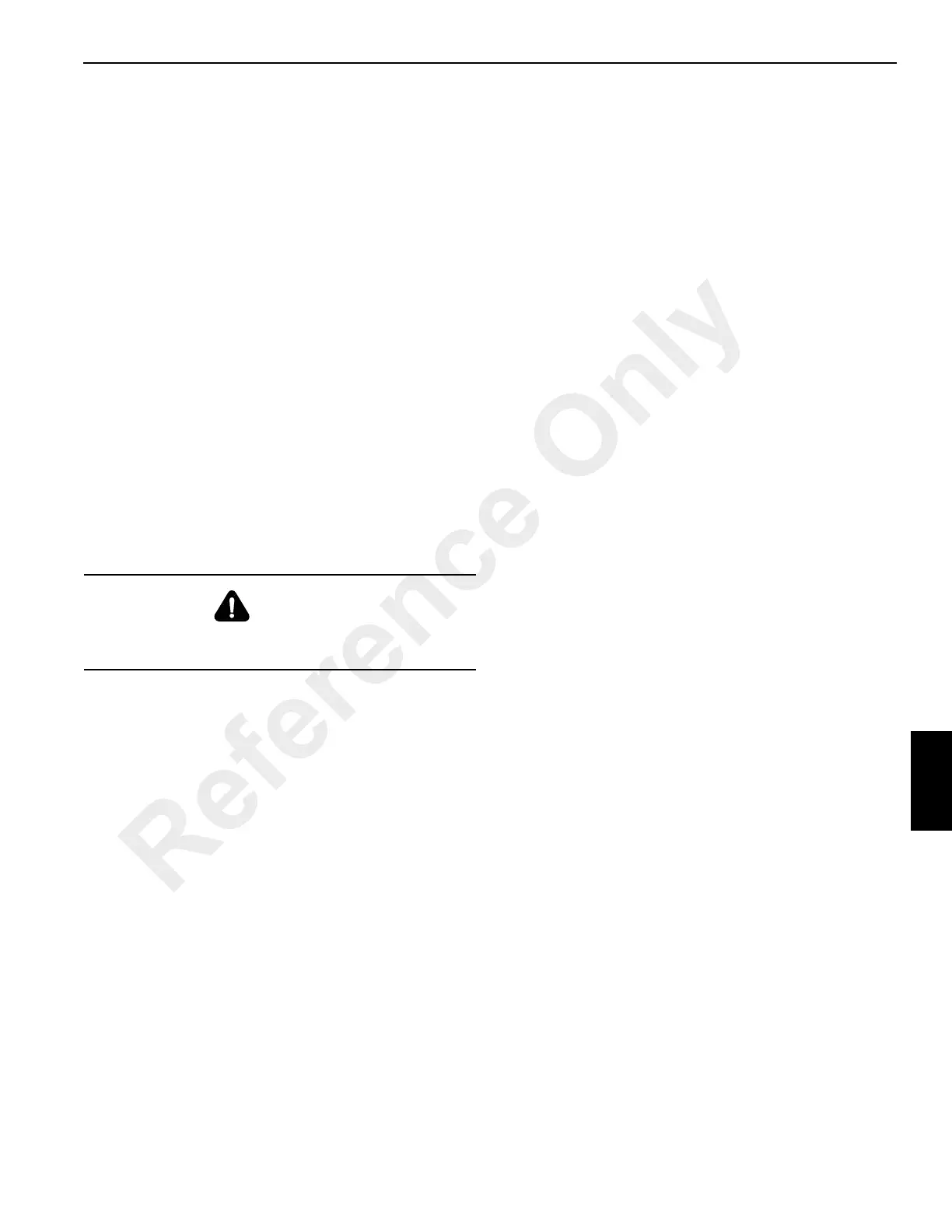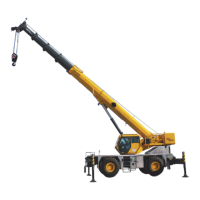GROVE Published 10-21-2010, Control# 198-04 7-55
5540F/YB5515 SERVICE MANUAL TRANSMISSION AND TORQUE CONVERTER
Hydraulic 2/4-Wheel Drive Unit Disassembly
and Assembly (Spring ON/Pressure OFF
Type)
NOTE: Before disassembling the unit drain the gearbox oil.
Disassembly, see Figure 7-92
1. Hold the yoke E and remove bolt F. Remove the yoke.
Carefully remove and discard oil seal M. Be sure not to
damage the seal housing.
2. Remove bolts D. Lift off the 4WD casing P. Lift out the
4WD unit from the gearbox.
3. Remove bearing 1, only if to be renewed.
4. Remove seal ring 2.
NOTE: If the piston ring seal is damaged or excessively
worn then check for burrs or damage on the shaft
groove. If necessary remove burrs with a fine grade
abrasion paper and oil.
5. Pull off the 4WD output gear 5, together with its bearing
3, needle roller bearing 6 and thrust washer 4.
6. Using a suitable press, compress disc springs 8A, 8B
and remove the circlip 7.
7. Remove disc springs 8A, 8B, pressure plate 9, shim(s)
10 (keep the shim(s) separate from the counter plates),
and clutch pack friction plates and counter plates 11.
8. Remove the clutch drum retaining circlip 12 and support
washer 13.
9. Remove clutch drum 14 and actuating sleeve 15.
10. Remove disc spring 16.
11. Remove the piston 17 and its spring steel ring 18.
12. Remove and discard piston O-rings 19 and 20.
13. Remove the piston housing 21 only if necessary, the
housing is a press fit on shaft 22.
Inspection
Perform a visual inspection of the friction and counter plates.
Counter plates - light scoring/polishing is permissible, plates
that are not flat, worn or heavily marked or scored must be
replaced with a new set.
Friction plates - the cross hatching should be clearly visible,
plates that are not flat, have friction material damage or
scoring must be replaced with a new set.
Do not mix old, new and worn plates.
Two different suppliers of the thinner friction plates 0.062 to
0.067 in (1.6 to 1.7 mm) approximately have been used
(identified as brown or green), do not mix the different plates
in the same clutch pack.
Assembly
NOTE: Use the pressure test adaptor and clamp assembly
(see Service tools, Section 1) to 'bench test' the
clutch. Bench testing will ensure the clutch
operates correctly prior to re-assembling and
installing in the machine. Refer to Pressure
Testing.
1. Grease the shaft 22 then install the piston housing 21 by
pressing the shaft squarely into the housing (make sure
the housing is securely supported on the centre boss).
2. Install new O-rings 19 and 20 to piston 17, locate the
piston into housing 21. Install spring steel ring 18
ensuring that it seats firmly in its groove.
3. Place the disc spring 16 into the housing 21.
4. Position the actuating sleeve 15 onto the disc spring 16.
5. Install the clutch drum 14 in the housing. Install support
washer 13 and drum securing circlip 12.
6. Build up the clutch pack 11, installing friction plates and
counter plates alternately, starting with a counter plate
and finishing with a friction plate. Use the 4WD output
gear 5 to align the clutch plate splines.
7. Install shim(s) 10 and pressure plate 9.
8. Place the first two disc springs 8B with their convex
sides uppermost, onto the clutch pack. (There are four
disc springs, which are identical). Place the other two
disc springs 8A, with their convex sides down, onto the
first two - refer to inset A.
9. Using a suitable press, compress the disc springs 8A
and 8B, fit circlip 7.
10. Use levers to remove free play, as shown at B. Measure
the gap between pressure plate 9 and actuating sleeve
15, The gap should be 0.030 - 0.059 in (0.75 - 1.5 mm).
If necessary install new shim 10 to achieve the correct
gap. (Shim 10 can be a combination of a single counter
plate, shim (thinner than the counter plate) or both
counter plate and shim). Check that the clutch pack
splines are still aligned - see step
6.
11
. Inst
all the 4WD output gear 5 and its needle roller
bearing 6. Check the operation of the clutch using
service tool 993/59300, see Pressure Testing.
CAUTION
There is approximately (6000 lbf) 26700 N clamping force
acting on the springs.
Reference Only

